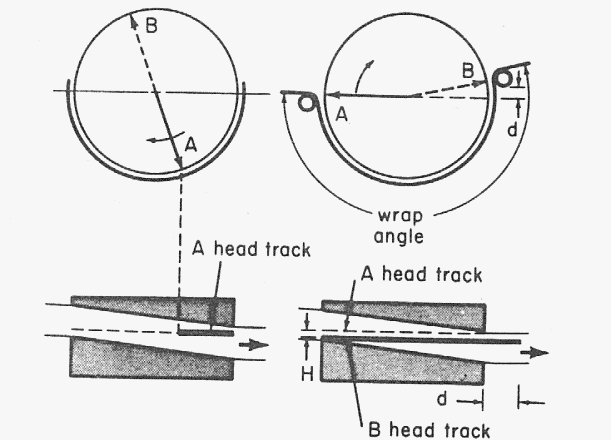| LabGuy's World: Sony CV-2xxx
Skip Field Format
The Skip Field Method, a primer: 
The Sony Skip Field Method Diagram. For recording purposes, the video signal is applied to only one of the rotating video heads. This head is designated the A head. As a result, alternate fields are not recorded. The skipped fields are those that occur during the half revolution when the A head is not in contact with the tape. During playback, the signals is extracted from both the A and B heads. The B head is arranged to scan the same track traced by the A head on the previous half revolution. In this way, two identical fields are played back to form a complete frame. However, since there is little change in video information between alternate fields, the change in picture quality is negligible. This system affords a saving in tape area required for recording, and makes possible long playing times with the tape that existed in the early 60's. To make the B head scan the track of the A head, the relative positions of the heads must be arranged as follows. The diagram shows a solid line representing the track of the A head. The right hand diagram shows the position of that track a half of a revolution of the head assembly. Tape travel causes the track to move downwards by the distance H. Thus the B head must rotate in a horizontal plane that is below that of the A head. In addition, the beginning of the track moves the distance d in the time taken for a half of a revolution. This means that the B head will miss part of the track and begin its scan after part of the recorded vertical field has left the head drum assembly. To correct this condition, the B head is not 180 degrees from the A head. But is retarded slightly as shown at the right of the diagram. (This adjustment was made at the factory and cannot be reset in the field.) The tape is also wrapped around the drum for more than 180 degrees. The "wrap angle" is actually large enough so that an overlap exists between the signals read out by the heads during playback. This overlap occurs during the vertical blanking interval and is not visible on the screen. [HOME]......[EXTINCT DOCUMENTATION]......[EXTINCT FORMATS] Last updated: January 11, 2005 |